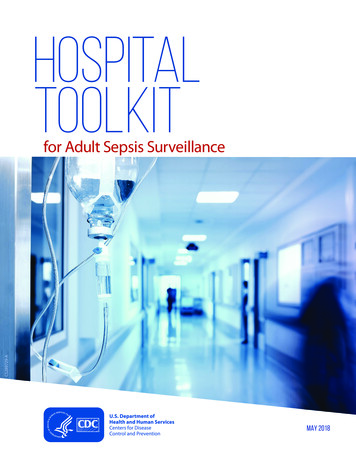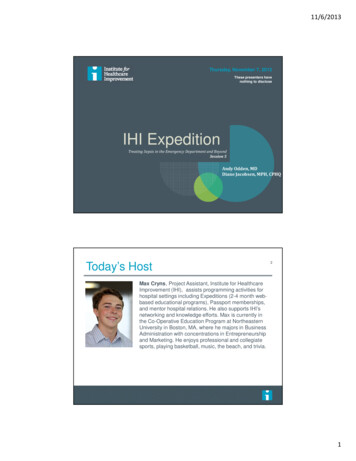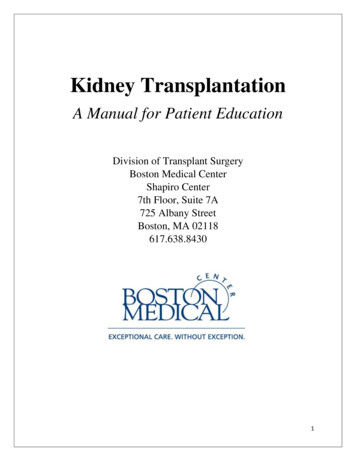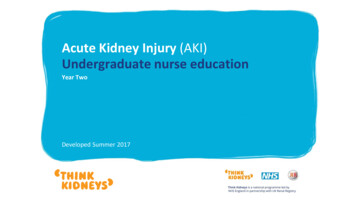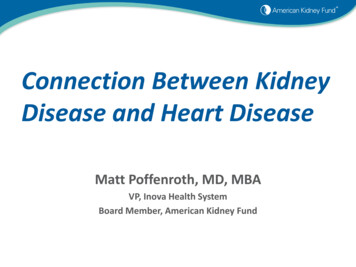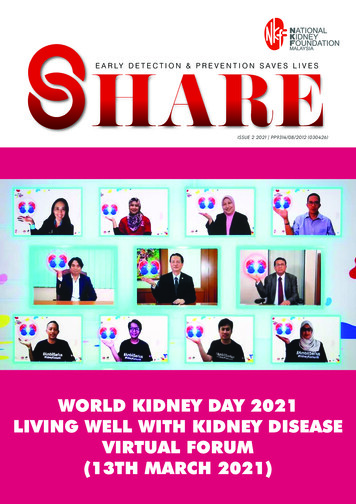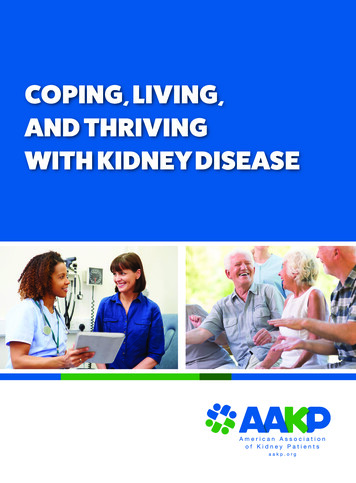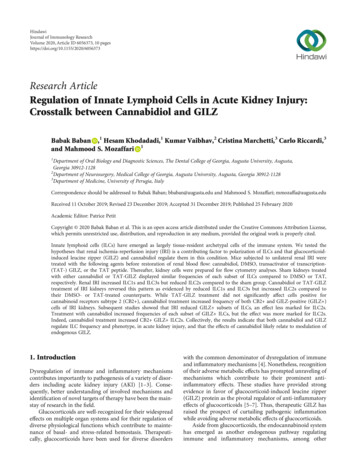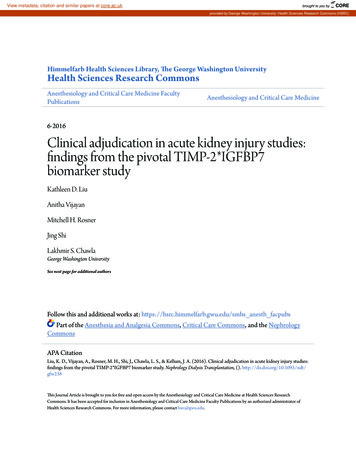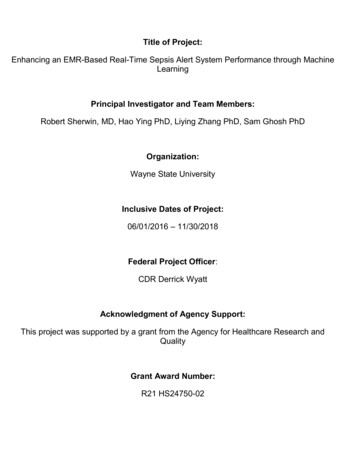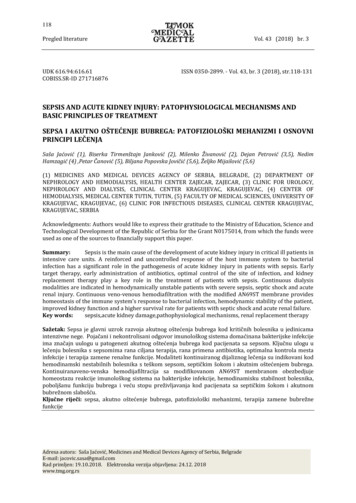
Transcription
118Pregled literatureUDK 616.94:616.61COBISS.SR-ID 271716876Vol. 43 (2018) br. 3ISSN 0350-2899. - Vol. 43, br. 3 (2018), str.118-131SEPSIS AND ACUTE KIDNEY INJURY: PATOPHYSIOLOGICAL MECHANISMS ANDBASIC PRINCIPLES OF TREATMENTSEPSA I AKUTNO OŠTEĆENJE BUBREGA: PATOFIZIOLOŠKI MEHANIZMI I OSNOVNIPRINCIPI LEČENJASaša Jaćović (1), Biserka Tirmenštajn Janković (2), Milenko Živanović (2), Dejan Petrović (3,5), NedimHamzagić (4) ,Petar Čanović (5), Biljana Popovska Jovičić (5,6), Željko Mijailović (5,6)(1) MEDICINES AND MEDICAL DEVICES AGENCY OF SERBIA, BELGRADE, (2) DEPARTMENT OFNEPHROLOGY AND HEMODIALYSIS, HEALTH CENTER ZAJECAR, ZAJECAR, (3) CLINIC FOR UROLOGY,NEPHROLOGY AND DIALYSIS, CLINICAL CENTER KRAGUJEVAC, KRAGUJEVAC, (4) CENTER OFHEMODIALYSIS, MEDICAL CENTER TUTIN, TUTIN, (5) FACULTY OF MEDICAL SCIENCES, UNIVERSITY OFKRAGUJEVAC, KRAGUJEVAC, (6) CLINIC FOR INFECTIOUS DISEASES, CLINICAL CENTER KRAGUJEVAC,KRAGUJEVAC, SERBIAAcknowledgments: Authors would like to express their gratitude to the Ministry of Education, Science andTechnological Development of the Republic of Serbia for the Grant N0175014, from which the funds wereused as one of the sources to financially support this paper.Summary:Sepsis is the main cause of the development of acute kidney injury in critical ill patients inintensive care units. A reinforced and uncontrolled response of the host immune system to bacterialinfection has a significant role in the pathogenesis of acute kidney injury in patients with sepsis. Earlytarget therapy, early administration of antibiotics, optimal control of the site of infection, and kidneyreplacement therapy play a key role in the treatment of patients with sepsis. Continuous dialysismodalities are indicated in hemodynamically unstable patients with severe sepsis, septic shock and acuterenal injury. Continuous veno-venous hemodiafiltration with the modified AN69ST membrane provideshomeostasis of the immune system's response to bacterial infection, hemodynamic stability of the patient,improved kidney function and a higher survival rate for patients with septic shock and acute renal failure.Key words:sepsis,acute kidney damage,pathophysiological mechanisms, renal replacement therapySažetak: Sepsa je glavni uzrok razvoja akutnog oštećenja bubrega kod kritičnih bolesnika u jedinicamaintenzivne nege. Pojačani i nekontrolisani odgovor imunološkog sistema domaćinana bakterijske infekcijeima značajn uulogu u patogenezi akutnog oštećenja bubrega kod pacijenata sa sepsom. Ključnu ulogu ulečenju bolesnika s sepsomima rana ciljana terapija, rana primena antibiotika, optimalna kontrola mestainfekcije i terapija zamene renalne funkcije. Modaliteti kontinuiranog dijaliznog lečenja su indikovani kodhemodinamski nestabilnih bolesnika s teškom sepsom, septičkim šokom i akutnim oštećenjem bubrega.Kontinuiranaveno-venska hemodijafiltracija sa modifikovanom AN69ST membranom obezbedjujehomeostazu reakcije imunološkog sistema na bakterijske infekcije, hemodinamisku stabilnost bolesnika,poboljšanu funkciju bubrega i veću stopu preživljavanja kod pacijenata sa septičkim šokom i akutnombubrežnom slabošću.Ključne riječi: sepsa, akutno oštećenje bubrega, patofiziološki mehanizmi, terapija zamene bubrežnefunkcijeAdresa autora: Saša Jaćović, Medicines and Medical Devices Agency of Serbia, BelgradeE-mail: jacovic.sasa@gmail.comRad primljen: 19.10.2018. Elektronska verzija objavljena: 24.12. 2018www.tmg.org.rs
119Vol 43 (2018) br. 3INTRODUCTIONSepsis is the main cause of the development ofacute kidney injury in critical ill patients inintensive care units (sepsis-induced acutekidney injury - SI-AKI) (responsible for 20-50%of cases of acute kidney injury in these patients) 1-2 . The mortality rate of patients with septicshock and acute kidney injury is high andamounts to 50-80% 3 . Epidemiological studiesshow that 200000 patients die annually in theUnited States due to sepsis 4 . Critical illpatients in intensive care units with severesepsis, septic shock and acute kidney ement therapy (RRT), increased treatmentcosts and have a high risk of insufficiency ofother organs/systems and adverse outcomes.These patients require team approach, ologists and nephrologists. Early detectionof sepsis and acute kidney injury, coupled withearly target therapy, use of antibiotics andinitiation of appropriate supportive therapy cancorrect the outcome of critical ill patients inintensive care units [5].Definition of sepsisBacteraemia is defined as the presence ofbacteria in the blood of patients. The patient'sresponse to a bacterial infection (systemicinflammatory response syndrome -SIRS) isdefined as the presence of 2 of the followingcriteria: body temperature 38,0OC or 36,0OC,heart rate 90 beats per minute, breathingfrequency 20 respirations in minute or partialpressure of carbon dioxide - pCO2 32 mmHg, thenumber of white blood cells 12 x 109/L or 4 x109/L or the normal number of white blood cellswith 10% immature cell forms. Sepsis is definedas the systemic inflammatory responsesyndrome to proven infection caused by thebacteria, and severe sepsis as a sepsis associatedwith organ function disorder - SOFA score 2(sequential organ failure assessment - SOFA).Severe sepsis progresses to septic shock, whichis defined as a persistent hypotension that doesnot repair after resuscitation of volume with0.9% NaCl solution of crystalloid at a dose of 4060 ml/kg of body mass in the first hour,requiring the use of vasopressor norepinephrinein a dose 5 μg/kg/min to maintain a meanarterial blood pressure–MAP 65 mmHg,Pregled literatureassociated with clinical data for hypoperfusion(serum lactate concentration greater than 2mmol/l) and organ function disorder (SOFAscore 2). Refractory septic shock is defined asthe need for norepinephrine at a dose 15μg/kg/min in order to achieve the target value ofMAP 65 mmHg. In intensive care units, fordetecting patients with suspected infection orproven infection and adverse outcome, a quickSOFA score (qSOFA) is used. Patients withqSOFA 2have the risk of prolonged hospitaltreatment and adverse outcome (altered state ofconsciousness: the Glasgow Coma Scale - GCS 15, breathing frequency 22 respirations perminute, serum lactate concentration greaterthan 2 mmol/l. In patients with sepsis, withqSOFA score 2, a standard SOFA score shouldbe made to detect organ function disorders 6 .Renal injury exists if serum creatinineconcentration increases by more than 44.2 mol/l or 0.5 mg/dl compared to basal value,and urine output decreases below 0.5 ml/kg/h.A ratio of partial pressure of arterial oxygen tothe fraction of inspired oxygen - PaO2/FiO2 ratio 300 indicates a lung function disorder, andGCSless than 15 for brain function disorder [67].Definition of acute kidney injuryFor the definition and assessment of the severityof acute kidney injury, clasifications RIFLE2004(Risk, Injury, Failure, Loss, End-stage), aswell as AKIN 2007(Acute Kidney InjuryNetwork) and KDIGO 2012(Kidney DiseaseImproving Global Outcomes) are used. Based onthe AKIN classification, acute kidney injury stage1 is defined as an increase in serum creatinineby 26.5 mol/l ( 0.3 mg/dl) or as an increasein serum creatinine concentration 1.5timescompared to basal creatinine in the serum in theprevious 48 hours and/or as a urine output lessthan 0.5 ml/kg/h for at least 6h. Based on theKDIGO classification, stage 1 of acute kidneyinjury is present in those patients who have aserum creatinine concentration of 1.5-1.9 timescompared to basal, and urine output less than0.5 ml/kg for 6-12h. The stage 2 of acute kidneyinjury is characterized by an increase in serumcreatinine concentration of 2-2.9 timescompared to basal and/or urine output less than0.5 ml/kg/h for 12 h. The third stage of KDIGOclassification of acute kidney injuries rg.rs
120Pregled literatureVol. 43 (2018) br. 3concentration 3 times within seven days, orincrease in serum creatinine 354 mol/l ( 4mg/dl), with an acute increase of 0.5 mg/dL orinitiation of RRT, and/or urine output 0.3ml/kg/h for 24h, or anuria for 12h 8 .INSUFFICIENCY OF ORGANS AND SYSTEMS INSEPSISAcutedamageimpairment in velopment of acute kidney injury in patientswith sepsis may be hemodynamic and ismsinclude:hypoperfusion of the kidneys, increased intraabdominal pressure, increased central venouspressure and blood stasis in the venous systemof the kidneys. In the last decade, new nonhemodynamic pathophysiological mechanismsof the development of acute kidney injury inpatients with sepsis have been discovered: theincreased systemic and local responses of thehost immune system to infection, increasedproduction and secretion of proinflammatorymediators, "cytokine storm" (disturbance of thebalanceofproinflammatoryandantiinflammatory cytokines in favour ofproinflammatory), endothelial dysfunction of thekidney microvasculature, infiltration of renalparenchyma with immune system cells(monocytes / macrophages, neutrophils /leukocytes), activation of epithelial cells ofproximal tubules through activation of Toll-likereceptors - TLRs and oxidative stress (disorderof equilibrium of oxidative and antioxidativesystem in favour of oxidative) [9-11].The enhanced and uncontrolled response of thehost immune system to infection plays animportant role in the development of acutekidney injury. Microorganisms and theirproducts/molecular structures - pathogenassociated molecular patterns (PAMPs), such aslipopolysaccharide, lipoteichoic acid, flagellin,DNA of the bacteria are recognized by tollreceptors [receptors that recognize molecularstructures - pattern recognizing receptors(PRRs) on the surface of the immune es)]. Activation of thesereceptors activates the cascade of signals thatwww.tmg.org.rsactivate the transcription factors [(nuclear factorkappa B (NFkB), activator protein 1 (AP-1),interferon regulatory factor 3 (IRF3)], all ofwhich results in increased formation and releaseof proinflammatory cytokines. TLRs areessential for the enhanced activation of theinnate immune system of the host to infectioncaused by bacteria. The immune response of thehost can be enhanced by molecules/molecularstructures released from necrotic host cells damage-associated molecular patterns - DAMPs,such as chromatin-associated protein highmobility group box 1 - HMGB1 and heatshockproteins - HSP, histones and /molecularstructuresbindtoTLR2/TLR4 on the surface of the cells of theinnate immune system of the host in theperipheral blood (monocytes/leukocytes) andalso stimulate the formation and release ofproinflammatory mediators. The recognition oftheseendogenousmolecules/molecularstructures results in the development of "sterileinflammation", which contributes to theincreased and uncontrolled response of theinnate immune system of the host to thebacterial infection (a vicious circle develops). Akey role in the development of acute kidneyinjury in patients with sepsis has the activationof epithelial cells of proximal tubules by PAPMsand DAMPs molecules/molecular structures.PAMPs and DAMPs molecules/molecularstructures are filtered into glomeruli, reach tothe lumen of proximal tubules, bind to andactivate the toll-like receptors (TLR2/TLR4)expressed on the luminal surface of epithelialcells of proximal tubules. Previous studies haveshown that the highest significance in theinduction of acute kidney damage in patientswith sepsis has the pathway of HMGB1-TLR4signals (response of the local immune system ofthe kidney). Stimulated epithelial cells ofproximal tubules increase the production andsecretion of proinflammatory cytokines (theresponse of the local immune system of thekidney enhances the response of the systemicimmune system to the bacterial infection: aviciouscircledevelops) 9-11 .Releasedproinflammatory cytokines from activatedepithelial cells of proximal tubules tes) induce endothelial dysfunction,disorder of microcirculation of the kidney(peritubular capillary network), ischemia of
121119Vol 43 (2018) br. 3epithelial cells of proximal tubules, oxidativestress, mitochondrial function disorder (reducedATP production) and stop the growth ofepithelial cells of proximal tubules in the G1phase of mitosis. Two key factors involved in thestopping of growth of proximal epithelial cellsare insulin-like growth factor binding protein 7(IGFBP7)andtissueinhibitorofmetalloproteinase 2 (TIMP-2). The results of theresearch performed so far show that thestopping of growth of epithelial cells of theproximal tubules plays a significant role in thedevelopment of acute kidney damage induced bysepsis [12-13]. Detection and clear definition ofpathophysiologicalmechanismsofthedevelopment of acute kidney damage in patientswith sepsis provides the possibility n of epithelial cells ofproximal tubules [9-13].Acute damage and function disorderof the heart in sepsisSepsis is an enhanced and uncontrolled responseof the immune system of the host to infection,which results in acute damage and disorders ofthe function of several organs/system of organs,including sepsis-induced cardiomyopathy SICM. Cardiomyopathy induced by sepsis isdefined as an ejection fraction of the leftventricle less than 50% or as a reduction in theejection fraction 10% of the basal ejectionfraction and the recovery of myocardial functionin two weeks. Pathophysiological mechanisms ofacute damage and function disorder of the heartin sepsis can be: hemodynamic (reduced bloodflow through coronary arteries, myocardialischemia, coronary microcirculation disorderand nonhemodynamic (inflammation andinfiltration of the myocardial interstitiumby cellsof innate immune system), oxidative stress,nitric oxide - NO, endothelial dysfunction,apoptosis and necrosis of cardiomyocytes. slipopolysaccharide,lipoteichoic acid, flagellin, and DNA/RNA. Thesemolecules/molecular structures are bound tospecific receptors PRRs, such as TLRs on thesurface of the cells of innate immune system ofthe host in the peripheral blood, but also on thesurface of the cardiomyocytes. Receptors thatrecognize molecular structures - PRRs play a keyrole in enhancing the immune response of thePregled ular structures which arereleased from damaged cardiomyocytes,recognize and bind TLRs on the surface ialdysfunction, increased permeability of smallblood vessels of myocardial interstitum,infiltration of myocardial interstitium withinflammatory cells, negative inotropic effect ofproinflammatory mediators, cardiomyocytemitochondrial function disorders, es). All of this results in leftventricular dilatation with normal or low fillingpressure, development of systolic heart failure(left ventricularejection fraction - LVEF 50%)with normal or elevated stroke volume andcardiac index and with possible development ofcritical reduction in tissue perfusion(septicshock) 14 . Early application of antibiotics andsurgical removal of the focus (early control ofthe site of infection) are crucial for the optimaltreatment of patients with sepsis (they reducethe production of PAMPs molecules frombacteria). Optimization of the status of volemiaand cardiac function is achieved by the use ofcrystalloid solution, norepinephrine, and inpatients with cardiac index (CI) 2.2 l/min/m2administration of levosimendan is indicated(increases the sensitivity of the myofibrils tocalcium, improves left ventricular relaxation inthe diastolic phase, does not increase the use ofoxygen by cardiomyocytes and does not causeheart rhythm disturbances) 14-15 .Acute damage andfunction of the liver in sepsisdisorderofThe incidence of acute damage and disorder offunction of the liver in patients with sepsisranges from 30-50%. In patients with sepsis, twotypes of liver damage can develop: hypoxichepatitis (HH), and sepsis induced cholestasis(SIC). HH occurs as a consequence of septicshock due to reduced hepatic perfusion anddecreased oxygen utilization by hepatocytes(due to the action of inflammatory mediatorsand endotoxins) and is characterized bycentrilobular necrosis (CLN), a entration in the serum in the absence ofanother possible cause of necrosis of the liverwww.tmg.org.rs
122120Pregled literaturecells. Clinically, it can also be demonstrated byacute liver failure. Another importantpathophysiological mechanism of liver damagein patients with sepsis is cholestasis. Thedisorder of the bile salts transport occurs as aresult of the reduced activity of the bile saltexport pump (BSEP), which is located on thecanalicular side of the liver cells. The decrease inactivity is due to hypoperfusion, hypoxia, anddisorder of mitochondrial function of the livercells: lack of ATP. SIC is clinically manifested asa progressive increase in serum bilirubinconcentrations (increase in total bilirubin at theexpense of conjugated bilirubin) and jaundice.Due to intrahepatic cholestasis, decreased flowand bile inflow to the lumen of thegastrointestinal tract, there is an atrophy of themucous membrane of the intestine, loss ofbacteriostatic action, increased ons of endotoxins in these patients(enhancement of the systemic immune responseof the host to bacterial infection) [16-17]. Animportant role in acute liver damage also has theenhanced response of the systemic and localimmune system in the liver of the host r structures, which bind tospecific receptors - PRRs on the surface of theinnate immune system cells (monocytes,leukocytes), but also toTLRs (TLR2-TLR6) of theliver and Kupffer cells, have a key role in theenhanced response of the immune system of thehost and induction of the gene for the synthesisof proinflammatory cytokines, apoptosis andnecrosis of the liver cells (acute liver failure,acutisation of chronic liver failure) [18]. Thebasic principles of treating acute liver damage insepsis are early goal-directed therapy - tion,infectionsitecontrol,vasopressor support, and restoration of liverperfusion. Medicaments that have the potentialto induce cholestasis and hepatocellular damageshould be excluded [16-18]. An important role inthe treatment of these patients also havethedifferent albumin dialysis modalities [16-18].Acute damage and disorder of thefunction of the lung in sepsisAcute respiratory distress syndrome (ARDS) isdefined as an acute condition characterized bysevere hypoxia, bilateral pulmonary infiltrates,www.tmg.org.rsVol. 43 (2018) br. 3and absence of evidence of cardiogenicpulmonary edema. An important role in thedevelopment of acute damage and lung functiondisorders (acute respiratory distress syndrome,non-cardiogenic pulmonary edema) has areinforced and uncontrolled response of thesystemic and local immune system to thebacterial infection. PAMPs and DAMPsmolecules/molecular structures bind to TLRs onthe surface of the innate immune system cells inthe peripheral blood (monocytes/leukocytes), aswell as on the surface of the epithelial andendothelial cells of the alveolo-capillarymembrane of the lungs. After binding to TLRs onthe target cells (HMGB1-TLR4), the matory cytokines are increasinglyproduced and released. These mediators allowthe accumulation of neutrophils and T-cells,apoptosis of epithelial and endothelial lung cells,and the development of non-cardiogenicpulmonary edema. The disease develops 12-48hafter the initial event, and is clinically manifestedwith a feeling of choking and severe hypoxia.The diagnosis of ARDS is based on four criteria:rapid onset, bilateral infiltrates on the chestradiograph, normal cardiac function (pulmonarycapillary wedge pressure - PCWP) andPaO2/FiO2 ratio less than or equal to 200 19 .These patients are advised to lung protectiveventilation strategy - LPVS, with low respiratoryvolume (tidal volume of 6 ml/kg of ideal bodyweight), whereby end-inspiratory plateaupressure should be less than 30 cmH2O using thelowest positive end-expiratory pressure (PEEP 5-10 cmH2O) by which the satisfactoryoxygenation is achieved (PaO22 55-80 mmHgor SaHbO2 88 -90%) 20-21 . In severe form ofARDS (severe hypoxemia:PaO2/FiO2 80 mmHg,uncompensated hypercapnia: pH 7.2), thetherapy for extracorporeal carbon dioxideremoval - ECCO2R is indicated 22 .Acute damage and disorder of thefunction of the brain in sepsisSepsis-associated encephalopathy (SAE) isdefined as a diffused brain function disorder thatarises as a result of an increased anduncontrolled response of the host immunesystem to infection in the absence of a directcentral nervous system infection. In thedevelopment of acute damage and brain functiondisorders, in patients with sepsis there are
123119Pregled literatureVol 43 (2018) br. 3included three pathophysiologic pathways: theneuron/nerve pathway (activation of theafferent nerves, such as vagus and trigeminalnerves), the humoral pathway (cytokines incirculation) and the pathway of altered bloodbrain barrier (BBB). All three pathophysiologicpathways activate the microglial cells of thebrain (the first detected change in SAE).Activated microglial cells of the brain enhancethe production and secretion of nitric oxide,cytokines and free radicals – the reactive oxygenspecies(ROS), all of which results in theactivation of endothelial cells and an increasedBBB permeability (vicious circle), disorder offunctions of microcirculation of the brain,reduced cholinergic function and alteredneurotransmission, mitochondrial functiondisorder and brain cell apoptosis, developmentof acute damage and disorder of the function ofthe brain (encephalopathy associated withsepsis). Precipitating factors include metabolicdisorders and use of medicaments. The mainclinical features of acute encephalopathy causedby sepsis are: altered state of consciousness,cognitive disorder, cramping attacks and coma.The diagnosis of acute damage and disorder ofthe function of the brain is based on neurologicalexamination and neurological tests, such aselectroencephalography, transcranial Dopplerultrasound, computed tomography and nuclearmagnetic resonance. Treatment of SAE consistsof the application of early target therapy, earlyadministration of antibiotics, optimal control ofthe site of infection and precipitating factors(metabolic disorders, use of medicaments) 23 .Acute damagecoagulation in sepsisanddisorderofDisseminated intravascular coagulopathy occursin 35% of patients with severe sepsis (sepsisinduced disseminated intravascular coagulation- SI-DIC). An initial step in the development ofDIC in patients with sepsis is the increasedaccumulation of tissue factor (TF) on the surfaceof endothelial cells of small blood vessels. Aspart of the enhanced response of the immunesystem of the host to bacterial infection, PAMPsmolecules/molecular structures of the bacteria(lipopolysaccharide, peptidoglycan) activateTLRs (TLR2/TLR4) on the surface of theimmune system cells in the peripheral blood(monocytes, neutrophils). Activated neutrophilsenhance the production and secretion ofextracellular fibers consisting of DNA andnumerousbactericidalproteinssuchasneutrophil extracellular traps (NETs), whichare deposited on the surface of endothelial cellsand initiate the process of immunotrombosis.Further, DAMPs such as HMGB1 and histones,release from the activated immune system cellsand damaged tissue cells. These moleculesactivate TLRs on the surface of the endothelialcells, reduce the release of thrombomodulin(TM, anticoagulant effect), increase TFconcentration (procoagulant effect), increase theformation and release of proinflammatorycytokines ("sterile inflammation"), stimulateplatelet aggregation, lead to blood clotsformation in small blood vessels and thedevelopment of DIC. TM is an endothelialanticoagulant factor: it stimulates the formationof activated protein C (APC), binds to HMGB1and promotes its degradation by thrombin,so itprevents/blocks the binding of HMGB1 to thereceptor for advanced glycation end products(RAGE) on the surface of endothelial cells. TheTM/APC system plays a significant role inmaintaining homeostasis of thrombosis andhaemostasis, and in maintaining vascularintegrity (prevents the development of DIC inpatients with severe sepsis) 24-26 . Fourclinical forms of DIC syndrome aredistinguished: an asymptomatic form, a formwith positive results without bleeding and/orthrombosis, a form with increased bleeding anda clinical form with increased thrombosis. Theuse of recombinant human APC (rhAPC)isassociated with a high risk of bleeding. Inclinical practice, for the treatment of DIC inpatients with severe sepsis, antithrombin III isused (a loading dose of 6,000 IU/30 minutesfollowed by a continuous i.v. infusion of 6,000IU/day for 4 days), rhAPC (administered in theform of a continuous i.v. infusion of 24 μg/kg/hfor 96h) and recombinant human solublethrombomodulin (rTM). rTM is applied inpatients with SI-DIC accompanied with one ormorOorgan dysfunctions, wherein a value ofthe international normalized ratio (INR) is morethan 1.4, at a dose of 0.06 mg/kg/day for sixdays (i.v. infusion over 30 minutes/day, for sixconsecutive days) 24-27 .www.tmg.org.rs
124120Pregled literatureDIAGNOSISIndicators of sepsisThe number of leukocytes and serum C-reactiveprotein concentrations represent the "goldstandard" for diagnosing the infection.Procalcitonin (PCT) concentration in serum isused to diagnose sepsis, make a decision for theuse of antibiotics, and monitoring of theresponse to the applied antibiotic. The normalserum PCT concentration is less than 0.05 ng/ml(by some authors less than 0.1 ng/ml). Theserum PCT concentration below 0.5 ng/mlindicates local infection and inflammation, witha small risk of progression and severe sepsis(the concentration of PCT should be repeatedlychecked over the interval of 6-24h). Sepsis ispossible if the serum PCT concentration is 0.51.9 ng/ml (grey zone), and serum PCTconcentration 2 ng/ml indicates sepsis. Itconsiders that PCT elevation to 10 ng/mlindicates a severe sepsis, while level higher than10 ng/ml is associated with the development ofseptic shock. In patients whose serum PCTconcentration is 2 ng/ml, therapy withantibiotics should be initiated immediately. Theuse of antibiotics should be discontinued whenthe concentration of PCT in the serum dropsbelow 0.5 ng/ml [28-29].Indicators of acute damage and disorder offunction of the kidniesIn the last decade, a greater number of newindicators of acute kidney injury have beendetected (indicators more sensitive compared toserum creatinine levels): urinary neutrophilgelatinase-associated lipocalin (uNGAL), urinarykidney injury molecule (uKIM-1), a liver-typefatty acid binding protein (L-FABP), urinary IL18, TIMP-2, IGFBP-7 and cystatin C.Theconcentration of uNGAL 150 ng/ml two hoursafter the initial event indicates the developmentof AKI. Significant role in the early detection ofAKI have the growth factors of proximal tubuleepithelial cells: TIMP-2 and IGFBP-7. Thecombination of TIMP-2 and IGFBP-7 in the urineshowed good diagnostic performance in theearly detection of the risk of developing acuterenal failure within 12 hours. [TIMP-2]x[IGFBP7] 0.3 (ng/mL)2/1000 was superior for riskassessment of KDIGO stage 2 or 3 AKI whencompared to simultaneously measured plasmawww.tmg.org.rsVol. 43 (2018) br. 3and urine NGAL, plasma cystatin C, urine IL-18,KIM-1 and L-FABP [30-33].Indicators of acute damage and disorder ofthe function of the heartCardiac troponins (cTnT/cTnI) are used todetect damage of myocardium caused byischemia. An increase in troponin levels in serumof 20% compared to baseline indicatesischemic damage of cardiomyocytes, and valuesof 2 ng/ml indicate the development of acutemyocardial infarction [34]. For the diagnosis ofdisorder of cardiac contractile function,natriuretic peptides (BNP, NT-proBNP) are used.In patients with endogenous creatinineclearance greater than 60 ml/min/1.73m2, heartfailure exists if the serum BNP concentration isgreater than 100 ng/ml and the concentration ofNT-proBNP is greater than 400 pg/ml. If theendogenous creatinine clearance is less than 60ml/min/1.73m2, the heart failure is indicated bya BNP concentration greater than 200 pg/ml, orNT-proBNP greater than 1200 pg/ml 34 .Indicators of acute damage and disorder ofthe function of the liverThe most significant indicators of early liverdamage are aminotransferases enase(LDH),gammaglutamyltranspeptidase (GGT), total bilirubin, albumin,and parameters of the blood coagulation sferases concentrations are measured,while cholestatic liver damage is defined by anincreased concentration of ALP, conjugatedbilirubin and GGT [35]. In HH, serum bilirubinconcentration is normal or slightly increased,aminotransferase is increased up to 20 timesfrom the upper normal limit, LDH is alsoincreased (LDH 5000 IU/l), and the ALT/LDHratio is less than 1.5. Acute damage to the liverinduced by medications (hepatocellular damage)indicates an increase in ALT for 5 and the ratioALT/ALP 5. Cholestasis in patients with sepsisshows the total serum bilirubin concentration 2 mg/dl ( 34 mol/l) (increase of total bilirubinis at the expense of conju
www.tmg.org.rs UDK 616.94:616.61 ISSN 0350-2899. - Vol. 43, br. 3 (2018), str.118-131 COBISS.SR-ID 271716876 . Key words: sepsis,acute kidney damage,pathophysiological mechanisms, renal replacement therapy Sažetak: Sepsa je glavni uzrok razvoja akutnog oštećenja bubrega kod kritičnih bolesnika u jedinicama

